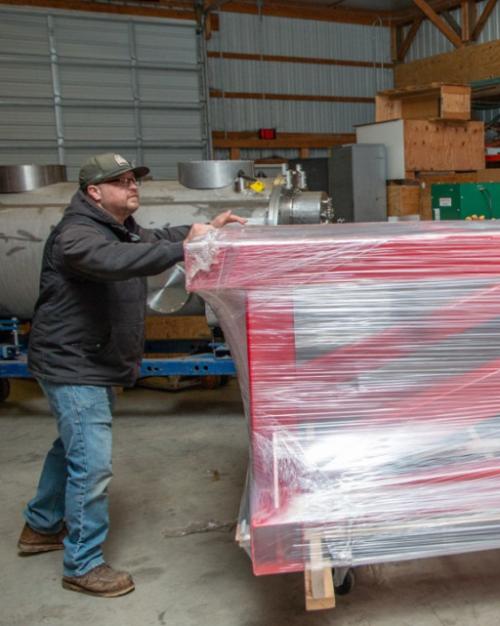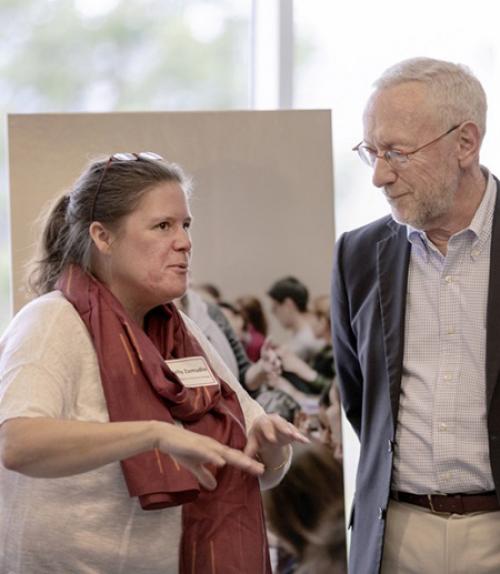The Provost’s Seminar on Teaching and Learning brought nearly 75 faculty and instructors together to share and celebrate innovations in teaching at Cornell.
Held April 18 in the Statler Hotel, the event was a showcase of Cornell’s ongoing teaching and learning initiatives and their progress.
The event began with remarks from Mathew Ouellett, executive director for the Center for Teaching Innovation (CTI), Julia Thom-Levy, vice provost for academic innovation and professor of physics, and Provost Michael Kotlikoff.
Kotlikoff recounted a renewed energy around teaching after President Martha E. Pollack’s call for “educational verve” in her inaugural address.
“We tried to think about how we can organize the creativity of Cornell faculty around teaching,” he said. “It was important to provide support, a ‘greenhouse’ where faculty could experiment, find expertise and guidance, and make progress. Today is an example of the success we’ve had so far.”
Said Thom-Levy: “Martha encouraged us to lower the anxiety barriers surrounding change and innovation. Teaching innovation is an iterative process.”
Attendees heard from a range of faculty who are implementing changes in their classrooms – from making their classes more inclusive, to piloting new technologies, to transforming courses with active learning strategies.
Natasha Holmes, the Ann S. Bowers Assistant Professor of Physics, described how the physics department has transformed introductory labs with support from the Active Learning Initiative.
“Traditionally,” she said, “the labs have been a mechanism for reinforcing the material in class. The students follow a prescribed set of procedures to get a prescribed outcome.”
Research has shown this kind of learning isn’t effective for a number of reasons, Holmes said. In response, she and her colleagues have restructured and reoriented the goals of the labs.
“Now it’s really about how we know rather that what we know in physics,” she said. “Students design experiments, analyze their data, make sense of their data and use that to make sense of the physical world – with no prescribed outcome that we expect them to get.”
As a physics education researcher, Holmes has tracked the results of these changes – which she describes as outstanding. Students are engaging in high-level decision-making, critical thinking and analysis about what they’re doing in an experiment, why they’re doing it and the outcomes.
This model also allows students to problem solve when the results don’t line up with their expectations.
“We think these skills are generalizable and transferable no matter where the students go,” Holmes said. “And, even though we’ve totally changed the goals and spent more time on fewer experiments, this has no impact on their performance on the traditional content.”
Durba Ghosh, director of the Feminist, Gender, & Sexuality Studies Program and professor of history, reported how changes in the structure of a foundational Feminist Theory course diversified the population of students in the program. The traditional way to teach the course, Ghosh said, is to begin with feminism in the 19th century and campaigns for universal suffrage.
“But teaching it this way locates the origin story for feminist studies in Europe and North America,” Ghosh said.
After participating in CTI’s Faculty Institute for Diversity, Ghosh reversed the order, beginning the course with black feminism and the centrality of slavery to black feminism and the black radical tradition.
“Of course this changed the sequence,” Ghosh said. “It also made it clear that we didn’t need to be thinking about sequences. Instead, we could think about interlocking and corresponding developments.”
As a result of this change and others, including incorporating active learning strategies, Ghosh said they have drastically increased the diversity in the FGSS program and the LGBT Studies program.
Other speakers included José Martínez, professor of electrical and computer engineering, who spoke about the impacts of creating an inclusive STEM classroom; Kelly Zamudio, the Goldwin Smith Professor of Ecology and Evolutionary Biology, who described transformations in one of her department’s gateway courses; Drew Margolin, assistant professor of communication, who spoke about his use of Canvas as a teaching tool; and Michelle Smith, associate professor of ecology and evolutionary biology, who talked about faculty working together to improve pedagogies in order to retain STEM majors.
Following the speakers, faculty had the opportunity to connect and talk at their tables, which fulfilled a key goal of the seminar: to build community around teaching.
“The main goal of today is to give you a chance to meet each other and talk about the very interesting teaching-related things you’re engaged in,” Ouellett said. “My experience in the academy is that there is extraordinary work going on in the classroom that sometimes people even at the departmental level may not know about. … Our goal is to facilitate more conversations like this at every opportunity.”
The Provost’s Seminar on Teaching and Learning is expected to be hosted again next spring by the Office of the Provost and CTI.
This story was oringially appeared in the Cornell Chronicle.




